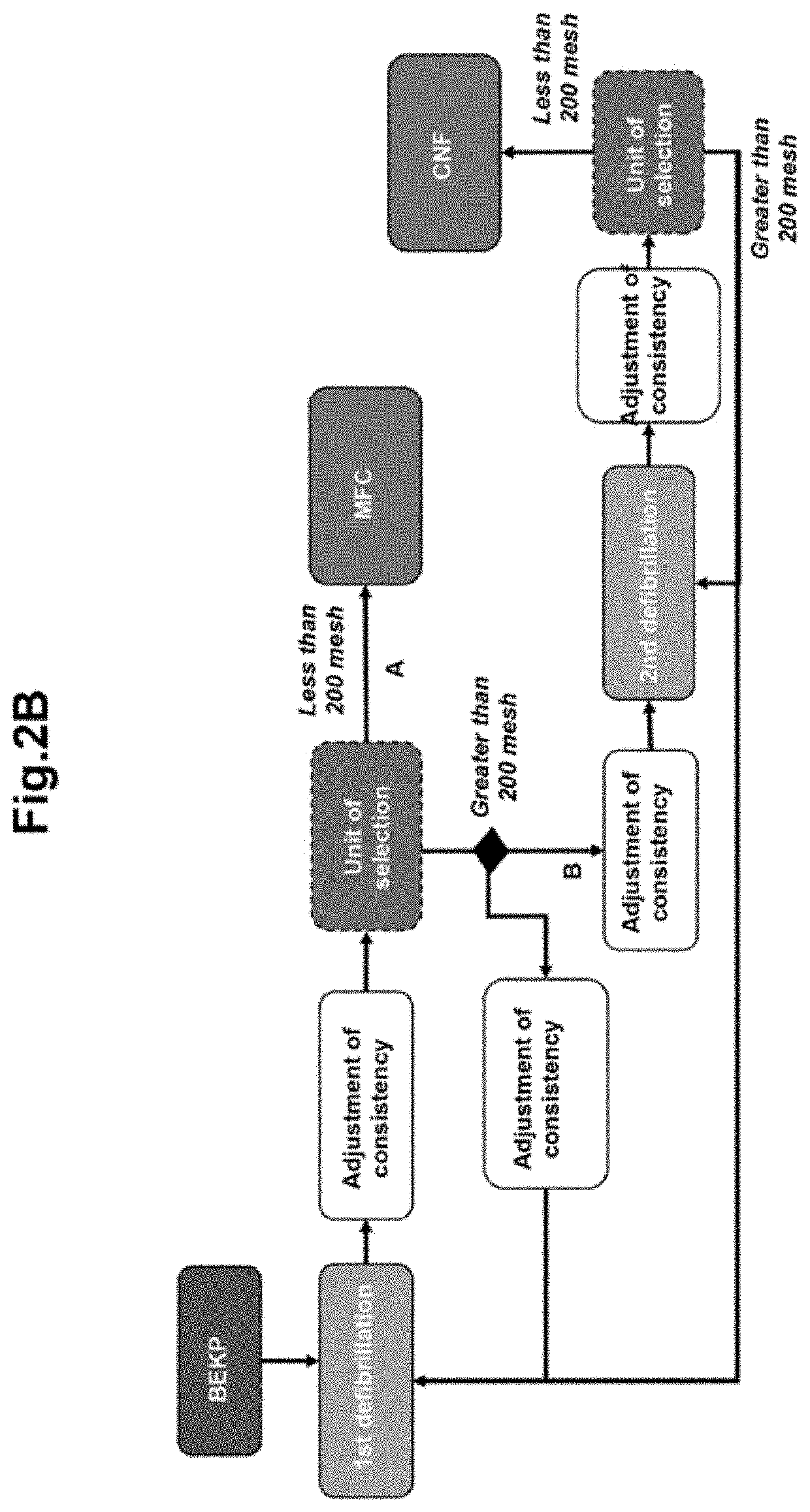Process for producing a nanocelullosic material comprising at least two stages of defibrillation of cellulosic feedstock and at least one intermediate fractioning stage
- Summary
- Abstract
- Description
- Claims
- Application Information
AI Technical Summary
Benefits of technology
Problems solved by technology
Method used
Image
Examples
example 1
[0055]According to the approach described in FIG. 2A, the process of the invention occurs between the pre-treatment, the defibrillation and the post-treatment. An eucalyptus bleached kraft pulp in suspension at 4% consistency (solids content) was subjected to the disc refining process for 6.0 h, until it reached 70.30% of L-fines content (fines in length base) or 33.35% of A-fines content (fines in area base) at 57.93±1.43° C. The resulting material was then subjected to a fractioning process at the Bauer McNETT unit employing screen / sieve with 200 mesh orifices. As a result of the fractionation stage, approximately 43% of mass recovery was obtained in the reject fraction (fraction collected in another stream that did not pass through the screen in the fractionation) and 56% in the accept fraction, with 22% and 94% of L-fines, respectively, for the reject and accept fractions. Both fractions underwent thickening (consistency adjustment) on silk screen (550 mesh), resulting in 21.28%...
example 2
[0060]According to the approach described in FIG. 2A, the process of the invention occurs between the pre-treatment, the defibrillation and the post-treatment. An eucalyptus bleached kraft pulp in suspension at 4% of consistency (solids content) was subjected to a disc refining process for 6.0 h, until it reached 70.30% of L-fines content (fines in length base) or 33.35% of A-fines content (fines in area base) at 57.93±1.43° C. The resulting material was then subjected to a fractioning process at the Bauer McNETT unit employing screen / sieve with 200 mesh orifices. As a result of the fractionation stage, approximately 43% of mass recovery was obtained in the reject fraction (fraction collected in another stream that did not pass through the screen in the fractionation) and 56% in the accept fraction, with 22% and 94% of L-fines, respectively, for the reject and accept fractions. Both fractions underwent thickening (consistency adjustment) on silk screen (550 mesh), resulting in 21.28...
example 3
[0063]According to the approach described in FIG. 2A, the process of the invention occurs between the pre-treatment, the defibrillation and the post-treatment. A bleached eucalyptus Kraft pulp (BEKP) in suspension at 4% of consistency (solids content) was subjected to a disc refining process (18.66 km / rev) for 6.0 h, until it reached 69.89% of L-fines content (fines based on length) at 57.93±1.43° C. The resulting material was then diluted to 3.5% of solids and subjected to a fractionation process with a pressurized basket with 75 mesh screen (200 μm). In this case, the fractionation occurred after diluting the suspension to 3.5% of consistency, with a reject rate per volume of 40% with a rotor speed of 12 m / s and an average passage speed of 0.07 m / s.
[0064]As the main results of the fractionation, it can be seen, as shown in Table 2, that the segregation of particles occurred according to their respective sizes, reflected in the values of average length of fibers in each fraction, a...
PUM
| Property | Measurement | Unit |
|---|---|---|
| Mesh size | aaaaa | aaaaa |
| Mesh size | aaaaa | aaaaa |
| Mesh size | aaaaa | aaaaa |
Abstract
Description
Claims
Application Information
 Login to View More
Login to View More - R&D
- Intellectual Property
- Life Sciences
- Materials
- Tech Scout
- Unparalleled Data Quality
- Higher Quality Content
- 60% Fewer Hallucinations
Browse by: Latest US Patents, China's latest patents, Technical Efficacy Thesaurus, Application Domain, Technology Topic, Popular Technical Reports.
© 2025 PatSnap. All rights reserved.Legal|Privacy policy|Modern Slavery Act Transparency Statement|Sitemap|About US| Contact US: help@patsnap.com



